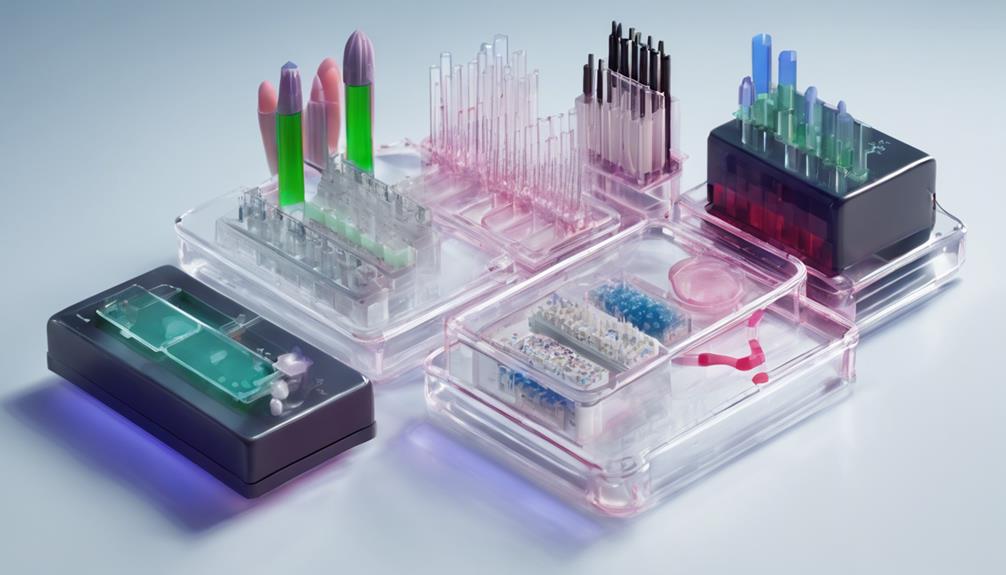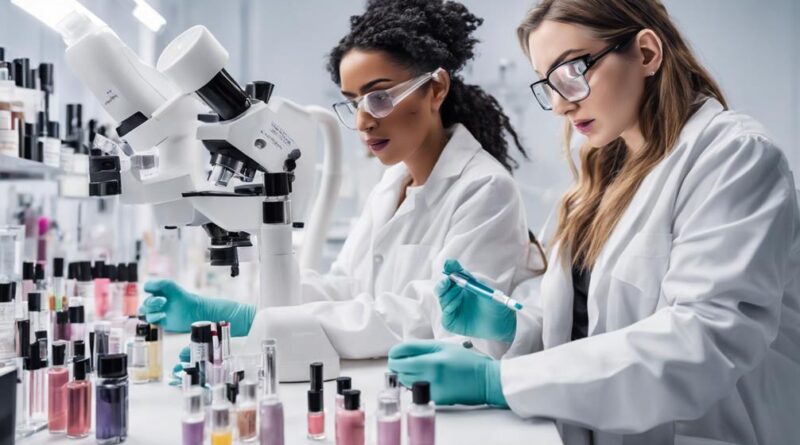7 Best Alternatives to Rabbit Cosmetic Product Testing
Discover advanced methods like human skin models, 3D skin models, and in vitro testing to replace rabbit cosmetic testing. Embrace technology such as artificial intelligence and computer simulations for innovative and precise results. Consider tissue engineering techniques to mimic human skin and organs effectively. Explore ethical alternatives that enhance accuracy and eliminate ethical concerns. Revolutionize the industry with high-tech solutions that predict allergic reactions and adverse effects. Additional applications include drug toxicity testing and personalized medicine. Uncover a world of sophisticated and ethical alternatives in the beauty industry that prioritize both innovation and ethical standards.
Human Skin Models
To advance cosmetic testing methods, consider utilizing human skin models as a more ethical and innovative approach. With the rapid advancements in tissue engineering techniques, scientists can now create 3D printed skin models that closely mimic human skin's structure and function. These models offer a more reliable alternative to traditional animal testing methods, providing a platform for conducting accurate and human-relevant experiments.
By leveraging tissue engineering techniques, researchers can tailor the 3D printed skin models to replicate different skin types, making them versatile for a wide range of cosmetic testing applications. These models can simulate various skin reactions, such as irritation, inflammation, and absorption rates, allowing scientists to assess the safety and efficacy of cosmetic products more effectively.
Furthermore, human skin models offer a more ethical approach to cosmetic testing by eliminating the need to harm animals in the process. By using 3D printed skin, researchers can gather valuable data on how cosmetic products interact with human skin without causing unnecessary suffering to animals. This shift towards human skin models not only aligns with ethical standards but also promotes innovation in the cosmetic industry by encouraging the development of more reliable testing methods.
Artificial Intelligence Technology
Artificial intelligence technology revolutionizes cosmetic testing methods by offering a sophisticated and ethical alternative to traditional approaches. Machine learning algorithms and deep learning applications are at the forefront of this transformation. These cutting-edge technologies have the potential to enhance the safety and efficiency of cosmetic testing while eliminating the need for animal experimentation.
Machine learning algorithms analyze vast amounts of data to identify patterns and make predictions. In cosmetic testing, these algorithms can assess the safety and efficacy of products by analyzing ingredient interactions and potential side effects. By leveraging machine learning, researchers can expedite the testing process and minimize the risks associated with human trials.
Deep learning applications, a subset of machine learning, enable computers to simulate human-like decision-making processes. This technology can be applied to predict allergic reactions, skin irritation, and other adverse effects of cosmetic products. By training neural networks on diverse datasets, deep learning algorithms can provide accurate and reliable predictions, reducing the reliance on animal testing.
Incorporating artificial intelligence into cosmetic testing not only accelerates the development of new products but also upholds ethical standards by prioritizing human safety. By embracing machine learning and deep learning technologies, the cosmetic industry can move towards a more sustainable and cruelty-free future.
3D Skin Models
With the advancement of cosmetic testing methods, the utilization of 3D skin models emerges as a groundbreaking and ethical approach in evaluating product safety and efficacy. These models, created through innovative tissue engineering techniques, such as 3D printed skin, offer a more accurate representation of human skin compared to traditional animal testing.
3D skin models mimic the structure and function of human skin, providing a platform for researchers to study the effects of cosmetic products in a controlled environment. By incorporating different cell types and layers found in human skin, these models can assess skin irritation, absorption rates, and overall product performance with greater precision.
The use of 3D skin models not only reduces the reliance on animal testing but also offers a more cost-effective and time-efficient alternative for cosmetic companies. Additionally, these models address the ethical concerns associated with animal testing, aligning with the growing demand for cruelty-free testing methods in the beauty industry.
In Vitro Testing Methods
Utilizing in vitro testing methods presents a progressive and conscientious approach to further advancing cosmetic product safety assessments beyond the capabilities of traditional animal testing. By employing cell cultures and tissue engineering techniques, researchers can simulate human skin and organ systems more accurately. These methods not only enhance the accuracy of results but also eliminate the ethical concerns associated with animal testing.
Biomimetic models, which mimic the structure and function of human tissues, play a crucial role in in vitro testing. These models provide a more realistic environment for studying the effects of cosmetic products on human skin, offering valuable insights into potential irritations or allergic reactions without harming animals. Additionally, advancements in 3D printing technology have revolutionized the creation of intricate tissue structures, enabling researchers to develop custom-made skin models that closely resemble human skin layers.
The integration of in vitro testing methods in cosmetic product assessments signifies a shift towards more ethical and innovative practices within the industry. By prioritizing the use of cell cultures, tissue engineering, biomimetic models, and 3D printing, companies can ensure the safety and efficacy of their products while upholding ethical standards and promoting sustainability. Embracing these cutting-edge techniques not only benefits animal welfare but also enhances the reliability and relevance of cosmetic testing processes.
Computer Simulations
Computer simulations offer a high-tech solution for refining cosmetic product testing processes and promoting ethical standards in research and development. Here's how they're revolutionizing the industry:
- Virtual Reality Simulations: Virtual reality simulations provide a realistic environment for testing cosmetic products without the need for animal subjects. This cutting-edge technology allows researchers to simulate various skin types and conditions accurately, providing valuable insights into product performance.
- Machine Learning Algorithms: By employing machine learning algorithms, computer simulations can analyze vast amounts of data to predict product safety and efficacy. These algorithms can identify patterns and trends that may not be evident through traditional testing methods, allowing for more accurate predictions and reducing the need for animal testing.
- Computational Modeling and Data-Driven Approaches: Through computational modeling and data-driven approaches, researchers can simulate the interactions between cosmetic products and human skin at a molecular level. This enables them to assess potential risks and benefits more efficiently, leading to the development of safer and more effective products while upholding ethical standards in research and development.
Embracing computer simulations in cosmetic product testing not only enhances precision and efficiency but also aligns with the ethical imperative of reducing animal testing in the beauty industry.
Microfluidic Systems
Embracing the advancement of technology beyond computer simulations, the integration of microfluidic systems offers a progressive approach to enhancing cosmetic product testing while prioritizing ethical standards and research efficiency. Microfluidic systems, also known as lab-on-a-chip platforms, replicate human physiological conditions on a miniature scale, allowing for precise control over cell cultures and microenvironments. These systems enable researchers to study the effects of cosmetic products on human tissues without the need for animal testing.
One significant advancement within microfluidic systems is the development of organs-on-chip. These devices mimic the structure and functions of human organs, such as the liver, skin, and lungs, providing a more accurate representation of human responses to cosmetic products. Organs-on-chip advancements have revolutionized the field of toxicology by offering a more reliable and humane alternative to traditional animal testing methods.
Organ-on-a-Chip Technology

Exploring the potential of Organ-on-a-Chip technology presents a cutting-edge solution in advancing cosmetic product testing with a focus on ethical practices and research efficacy. This innovative approach involves creating microscale systems that mimic the structure and function of human organs, providing a more accurate platform for testing the safety and efficacy of cosmetic products.
Here are three key aspects highlighting the significance of Organ-on-a-Chip technology:
- Tissue Engineering Applications: Organ-on-a-Chip technology integrates principles of tissue engineering to recreate the complex microenvironment of human organs. By culturing cells on these chips, researchers can observe how cosmetic products interact with different types of tissues, offering valuable insights into their effects without the need for animal testing.
- Drug Toxicity Testing: This technology isn't only beneficial for cosmetic testing but also holds immense potential in drug toxicity testing. Organ-on-a-Chip platforms can simulate the response of human organs to drugs, helping researchers identify potential toxic effects early in the development process and ultimately improving drug safety.
- Personalized Medicine and Disease Modeling: Organ-on-a-Chip models can be personalized using patient-derived cells, enabling the study of individual responses to treatments. Additionally, these systems can be used to model diseases, providing a platform for understanding disease mechanisms and testing potential therapeutic interventions more efficiently.
Frequently Asked Questions
How Do Consumer Preferences Impact the Choice of Alternative Testing Methods?
When considering alternative testing methods, consumer behavior plays a crucial role. The evolving market trends emphasize the importance of ethical practices in product testing.
Understanding consumer preferences can guide companies towards innovative testing methods that align with ethical standards and meet consumer demands.
What Are the Limitations of Using Artificial Intelligence in Cosmetic Testing?
When considering artificial intelligence in cosmetic testing, limitations arise in terms of accuracy, bias, and reliability. AI may struggle with nuanced assessments that require human judgment.
Bias can be introduced through the data used to train AI models. Additionally, the reliability of AI systems can be impacted by the lack of transparency in how they make decisions.
These factors must be carefully considered to ensure the ethical and effective use of AI in cosmetic testing.
Are There Any Ethical Concerns Associated With Using Organ-On-A-Chip Technology?
When considering organ-on-a-chip technology, ethical implications arise due to the use of human cells in these models.
Despite this concern, the scientific advancements offered by organ-on-a-chip technology present a promising alternative to traditional testing methods.
By replicating the functions of human organs, this innovative approach offers a more accurate representation of how cosmetic products may impact human health.
Balancing these ethical considerations with the potential benefits of this technology is crucial in moving forward responsibly.
How Do Regulatory Bodies View the Use of 3D Skin Models in Cosmetic Testing?
Regulatory perspectives on 3D skin models in cosmetic testing vary. Validation studies are crucial to gaining acceptance. These models offer innovative alternatives but need to meet rigorous standards.
Keep up with evolving guidelines to ensure compliance and ethical practices. Look for opportunities to contribute to the advancement of non-animal testing methods.
Stay informed and engaged in the dialogue surrounding the use of 3D skin models in cosmetic testing.
What Are the Cost Implications of Transitioning to Non-Animal Testing Methods?
When considering transitioning to non-animal testing methods, you need to account for the cost implications and regulatory requirements. Implementing new testing techniques may initially incur expenses for training, equipment, and validation studies. However, in the long run, adopting alternative methods can lead to cost savings through reduced animal maintenance and ethical concerns.
Regulatory bodies are increasingly accepting and even encouraging non-animal testing approaches, which can streamline approval processes and enhance your brand's reputation.
Conclusion
In conclusion, the advancements in alternative testing methods for cosmetics aren't only innovative but also ethical.
Human skin models, artificial intelligence technology, 3D skin models, in vitro testing methods, computer simulations, microfluidic systems, and organ-on-a-chip technology offer promising solutions that prioritize the well-being of animals.
By embracing these alternatives, the beauty industry can continue to thrive while also promoting a more sustainable and compassionate approach to product testing.
